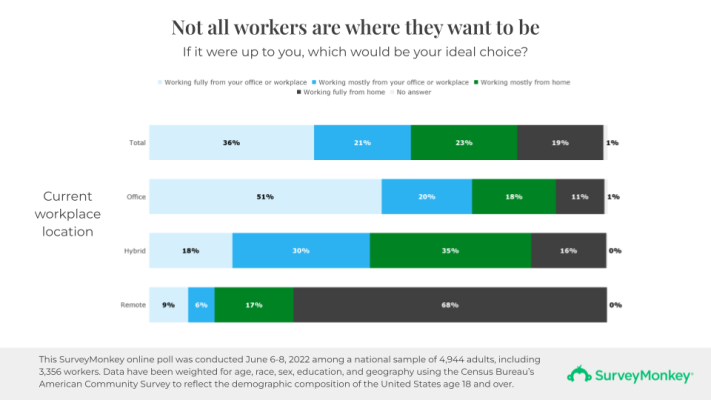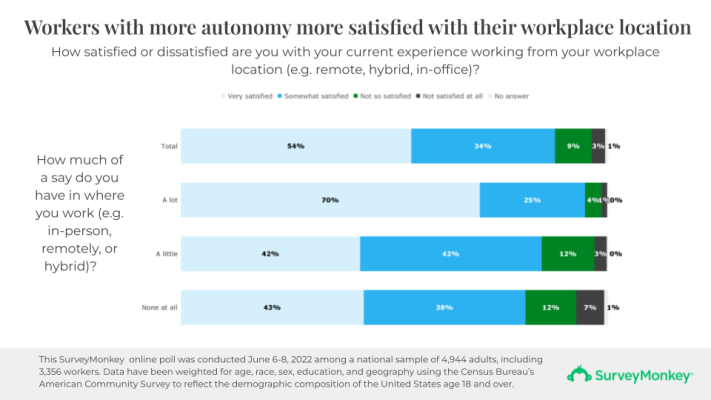Key findings:
- Returning to offices (for some): 58% of workers are back in the office, but 38% of in-office would prefer a hybrid schedule and 11% want to work fully from home
- Remote workers struggle to see the purpose of the office while in-office workers aren’t keen on WFH
- 9 in 10 workers are satisfied with their workplace location (e.g. in-person, remotely, or hybrid), but only 42% have “a lot” of say in where they work
- Hot job market: 41% of remote workers are more confident that they could find a new remote job now compared with six months ago
- The boss is watching: 56% of workers say their employer currently uses software to monitor their attendance or tasks at work
Most workers are back in the office, but not all want to be
After more than two years since the start of the COVID-19 pandemic, not all employees are where they want to be. Just half (51%) of in-office workers say their ideal workplace location is the office while 38% would prefer a hybrid schedule and 11% would prefer to work fully from home. Remote and hybrid employees are more satisfied with their workplace location:
- 68% of remote employees say their ideal workplace location is working fully from home
- 65% of hybrid workers prefer a hybrid schedule (30% say their ideal workplace is mostly from the office; 35% would prefer to work mostly from home)
Still, 16% of hybrid workers would prefer to work fully from home and 9% of fully remote workers would prefer to be in the office.

But few see a return to remote work on the horizon: just 33% of workers are more confident now than they were six months ago that their employer would let them work remotely if they wanted to. Another 31% are equally confident while 32% are less confident now.
Office workers ‘gung ho’ over the office while remote workers struggle to see its purpose
As COVID has blurred the line between home and the office, many employers -and employees- have begged the question: “what is the office for?” According to some remote employees, not much:
- Just 40% of remote workers say that the office makes it easy to have a work-life balance compared with 59% of hybrid workers and 74% of in-office workers
- 82% of office workers say that the office makes it easy to focus to get work done – far higher than that of remote (49%) and hybrid workers (70%)
- Only 58% of remote workers say the office makes it easy to showcase for and work with clients compared with 83% of in-office workers and 72% of hybrid workers
- 71% of remote workers say the office makes it easy to meet with colleagues for training, celebration and collaboration – the closest in agreement thus far between office (87%) and hybrid workers (80%)
Just as remote workers aren’t keen on the office, in-office employees are wary of remote work. Compared with remote workers, in-office workers are far less likely to agree that working from home makes it easy to do any of the following:
- have work-life balance (55% vs. 87% of remote workers);
- focus to get work done (51% vs. 84% of remote workers);
- showcase for and work with clients (44% vs. 69% of remote workers);
- or meet with colleagues (42% vs. 55% of remote workers).
However, remote work has its downsides too. Almost 4 in 10 (38%) workers who are either hybrid or fully remote are spending more hours working remotely compared with when they work (or used to work) in person. Another 4 in 10 (37%) are working about the same amount of hours while just 22% of remote workers are working fewer hours remotely.
- 47% of remote workers in households earning more than $100K are working more hours remotely compared with 37% of those in households earning between $50K-$100K and 32% of those in households earning less than $50K
9 in 10 workers satisfied with workplace location, though not all have a choice
Just 42% of workers have “a lot” of say in where they work (e.g. in-person, remotely, or hybrid). Some workers have less flexibility: 33% have “a little” say in where they work and 24% don’t have any say at all.
- Individual contributors have the least autonomy: just 35% of individual contributors have “a lot” of say in where they work compared with 45% of managers, 61% of senior managers, and 85% of C-level executives
- Those earning more are offered more flexibility: 49% of workers in households earning more than $100K have “a lot” of say in where they work vs. 42% of those in households earning between $50K-$100K and 38% of those earning less than $50K
Despite any lack of autonomy, the overwhelming majority of workers (88%) are satisfied with their current experience working from their workplace location (either in-office, remotely or hybrid).
- Workers with more say are more satisfied: 95% of workers who have “a lot” of say in where they work are satisfied with their current workplace location compared with workers who don’t have any say in where they work (81%) or “a little” say (85%)
- 76% of Remote employees are “very satisfied” with their workplace location – far greater than the 52% of in-office and 51% of hybrid workers who say the same

Amid economic woes, remote workers remain confident
Despite rifts of economic turbulence and instability, remote and hybrid workers remain confident in the job market. Four in 10 (41%) remote workers are more confident now than they were six months ago that they could find another job that allows them to work remotely. Fewer (31%) are equally confident and 26% are less confident now.
- Young workers bolster overall confidence: 48% of remote workers age 18-34 are more confident that they could find another remote job now compared with 40% of remote workers age 35-64 and 27% of remote workers age 65+
- 46% of workers in households earning more than $100K are more confident now while just 40% of workers in households earning between $50K-$100K and 37% of workers in households earning less than $50K say the same
Over half of workers under productivity surveillance
Over half (56%) of workers say their employer currently uses software to monitor their attendance or tasks at work.
- In-office workers are more likely than remote workers to say their employer uses software to monitor their productivity (61% vs. 48%)
- 62% of individual contributors say their employer currently uses software to monitor their productivity compared with 58% of managers, 35% of senior managers and just 25% of C-level executives
Most workers say it’s easier for their employer to monitor the productivity of in-office workers at their organization (44%) rather than remote workers (8%). However, 44% say their employer can monitor the work of both types of employees equally.
Read more about our polling methodology here.
Click through all the results in the interactive toplines below:




